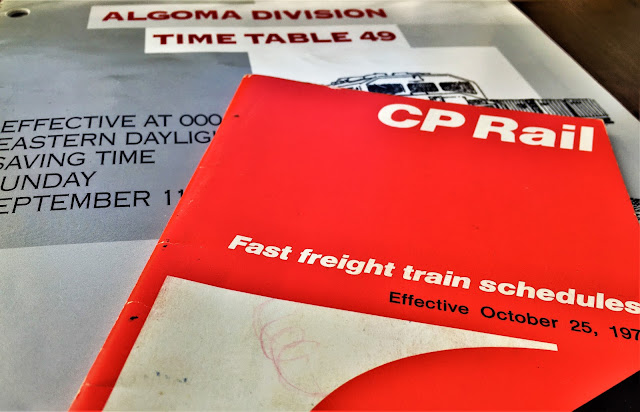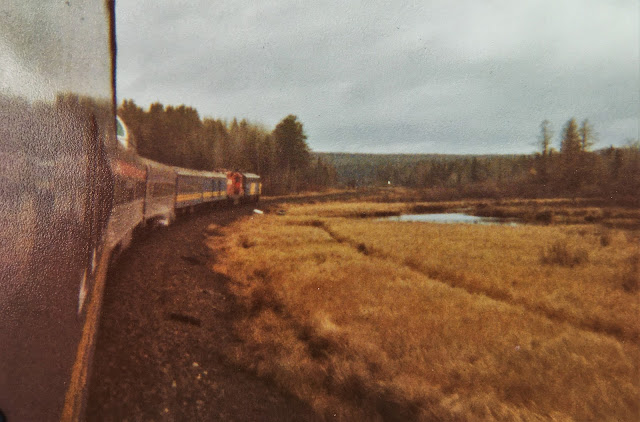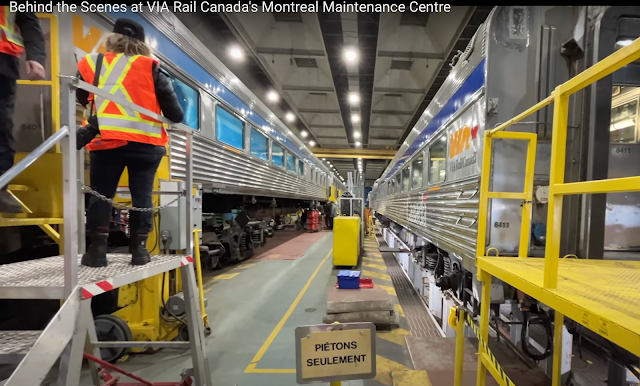As part of VIA's ongoing refurbishing of its ex-CP HEP1 equipment, a $16.4 million contract for work on its remaining diners was let to Rail GD of New Richmond, QC in October, 2018. The work was to be completed in the second quarter of 2020 and was to include i
nstalling a new kitchen and devices to make the cars Wi-Fi ready for future deployment, carrying out a mechanical upgrading and replacing various electronic and electrical components. Rail GD features the diner project on their website. As with most contracts these days, there were delays and cost over-runs, though ideally adding 25 years of useful life to the diners.
Rail GD boasts a modern shop with an area of 2,230 square metres and three tracks each 65 metres long that can accomodate six cars. The company had also performed repairs to Manors and other VIA equipment, as well as Rocky Mountaineer. This uncredited photo posted to social media shows the Rail GD shop interior, with three diners undergoing refurbishing.
The first of the refurbished diners, Annapolis, received the teal-and-yellow window-band "D&H" scheme. The succeeding cars did not receive this scheme, and most of the refurbishing can only be seen on their interiors. It was during the refurbishing of Annapolis in 2018 that structural integrity issues were first detected that would result in emergency inspection, some structural repair, and eventually imposition of a ministerial order and implementation of buffer cars on HEP consists in October, 2022. The repair costs due to corrosion exceeded the budgeted costs, so the contract requirements likely had to be revised for the remaining cars.
As of April, 2023 seven of the remaining 13 of CP's 18 diners have been refurbished. This post lists VIA's in-service diners as of April, 2023. I've listed them as "number/name" because although many VIAphiles refer to these cars by number, I always find referring to the Canadian equipment by name to be so much more classy! I will update this post in real-time as more cars are refurbished.
In February, 2024 during a media tour of the MMC, reporters saw a diner's kitchen and dining area that had been completely stripped on the interior (Acadian), and then the new version of the same car with a working kitchen, grey tables and chairs with a grey carpet and grey pull-down blinds (Imperial). VIA's VP of Mechanical Services Bouchard noted, “We’ve replaced the electric and air-conditioning systems. We've also revamped the whole kitchen to make it more ergonomic for the health and safety of the chefs on board. It’s been updated to all the standards as well, but the goal is to ensure the safety of all passengers.” This gives an idea of the scope of work VIA was doing in-house
* * *
8401/Acadian
In service. At Winnipeg for on-board staff training, will return to service for summer. Deadheaded east in April, 2023.
Being refurbished as of October, 2023. This video by Rail Fans Canada shows 8401/Acadian and 8411/Imperial (below) being refurbished at the MMC during the media opportunity publicizing VIA's RFP for a new long-distance fleet in February, 2024. Acadian and Imperial:Acadian is completely stripped in the dining area. The media tour did not go as far as the kitchen.
Acadian was still in the MMC in July, 2024. It headed west on VIA No 61 on September 6, 2024 with coach 8146, both likely on break-in runs, returning the same day eastward on VIA No 68. Acadian went west on VIA No 63 on October 9, and was on VIA No 1 deadheading from Toronto to Vancouver behind the power on October13.
* * *
8402/Alexandra
Stripped and torn-down
at CAD in Lachine, QC. Photo (above) kindly shared by Gerry Burridge, taken February 12, 2023. Scrapped onsite
.* * *
8404/Annapolis
The first diner refurbished at Rail GD, with a new kitchen and pantry. Released April, 2021 wearing the "D&H" scheme [the only diner that has received this scheme] added to the westbound Ocean at Matapedia. CFMG403 posted
this video showing the one-car movement at the 1:00 mark. I photographed it trailing VIA No 67 on July 15, 2021 (above) just west of Kingston.
In service, then returned to Rail GD and re-released in December, 2021.
In service since. Apparently stored at Vancouver station since February, 2024 not in active service since.
According to this VIA chef, here's why: "The car is disliked by onboard staff because it has a completely different workflow than all the other Diners (imagine being a chef on the Canadian for 20 years and suddenly there’s randomly one car with an entirely different kitchen layout and different appliances) and less storage space for their various sundries. The higher-tech kitchen features are mechanically unreliable and poorly designed. Spare parts support is limited because all the other diners underwent a less extensive overhaul, making the 8404 a “unicorn” with lots of unique parts that aren’t on the other ones."
August 26, 2025 - Annapolis operated on VIA No 693 to/from Churchill as there were no operable Skylines in Winnipeg. A rare use of a diner on the Churchill train.
* * *
8407/Emerald
The only diner given a Churchill wrap. We had the pleasure of dining in Emerald out and back on our trip aboard the Canadian in June, 2019 (above, westbound at Sioux Lookout, ON).
Emerald, Empress and Frontenac headed east as VIA No 614 on May 29, 2021 and were at Rail GD in June. Two units and three diners at the 1:11 mark
in this video by CFMG403 showing the movement. Refurbished and released in March, 2023 Emerald made a 'test run' on the Ocean Mar 15-18. Now wrapless, Emerald went west to Toronto on April 2's No 67, before deadheading west on No 1 departing Toronto on April 5.
In service.
Tim Hayman kindly shared this photo of the refurbished Emerald in Halifax duting its test run:
* * *
8408/Empress
Refurbished, Empress deadheaded west to Toronto on VIA No 51 on February 15, 2023.
In service, though not in active service October, 2023-July, 2024.
Empress control panel (above), VIA nameplate and Rail GD refurbishment (below):
Empress interior (below and top photo)
Member of Parliament Diane Lebouthillier posted this photo of truckless Empress to social media during a visit by Prime Minister Justin Trudeau to Rail GD on August 18, 2022:
* * *
8409/Fairholme
In service. Deadheaded east to Toronto on VIA No 2 February 9, 2024. In Montreal March, 2024 awaiting refurbishment. Being refurbished in the MMC in July, 2024, released September, 2024. Not seen in service until May 2, 2025 on No 2.
* * *
8410/Frontenac
Refurbished (interior), released by Rail GD July, 2022. Some of the refurbishing work is also now being done in-house by VIA. Frontenac deadheaded west with 8101 on VIA No 63 on November 17, 2022 (below - image courtesy Railstream, LLC), before trailing the tail-end buffer car on VIA No 1 on November 20. Interestingly, Frontenac rested in the West, at Vancouver from February until August, 2023 and again from October, 2023 to March, 2024!
In service.
* * *
8411/Imperial
Sent east, I photographed it looking rather empty while trailing VIA No 64 at Collins Bay, ON on March 19, 2023 (below) with a tiny accent aigu over the 'e' in Imperial!
Being refurbished as of February, 2024. Imperial will emerge with an unitalicized font nameplate.
During the VIA media opportunity in February, 2024 linked above under Acadian, these screenshots from the Rail Fans Canada Youtube video show Imperial looking complete:
Imperial has been in service since April, 2024.
* * *
8412/Kent
Last in service March, 2020; deadheaded to Montreal in May, 2020. Being refurbished. Refurbished and released in April, 2023 Kent made a 'test run' on the Ocean April 5-8. Kent headed west for service on the Canadian, trailing VIA No 61 on May 13.
Lesley Bernard kindly shared interior photos of Kent during its test run. Protective coverings still adorn the tables:
An end-door view, with a cropped close-up (above) shows table coverings and temporary carpet runner to keep everything nice and clean. A crew member mentioned that 'measuring equipment' was in the car therefore there could be no passenger access! Lesley notes that the steward's station is still in place, though photos on the Rail GD website (likely of Annapolis) show it has been removed.
The refurbished Kent heads west here on May 13 on the tail-end of VIA No 61 (image courtesy of Railstream, LLC). Kent departed Toronto on VIA No 1 Sun., May 21.
In service May-November, 2023, though not from December, 2023 to June, 2024. In service June, 2024 to March, 2025. Deadheaded east on No 2 May 16 to MMC, deadheaded west to Toronto on No 47 on July 6, 2025 thence deadheading No 1 on July 13.
* * *
8413/Louise
Was at CAD for work in March, 2020.
The last diner to be refurbished, in service as of October, 2024.
Deadheading east from Vancouver on VIA No 2 on December 6, 2024.
Still being worked on as of August 2, 2025 with no ETA for completion.
* * *
8414/Palliser
In service as of late-July, 2024. Deadheaded east on No 2 September 24, 2024 (on the same train as Louise, still in service). Deadheaded east on No 68 from Toronto on September 28, at MMC being refurbished as of October 1, 2024. Palliser was planned west on No 43 on Friday, August 1, 2025 returning east with coach 8110 as break-in runs. Deadheaded west on No 1 on Sunday, December 7, 2025.
* * *
8415/Princess
In service until October, 2019. P
rincess deadheaded east on VIA No 66 at Collins Bay on May 25, 2020 (below) while the Canadian was not running. Many cars came east in May for shop work including diners Acadian, Empress, Emerald, Fairholme, Frontenac and Kent came east. Acadian, Alexandra and Fairholme went west in June. Emerald headed west in March, 2021. Princess was photographed trailing an LRC consist on December 12, 2021, likely following refurbishing.
Refurbished, in service as of December, 2021. Deadheaded east on No 2 August 16, 2024 and not in service as of late-September, 2024.
* * *
8418/York
Out of service since 2019.
Being refurbished.
Making test runs on VIA Nos 68/61 in the last week of July. Unlike Emerald and Kent that made test runs on the Ocean, the Ocean was being short-turned at that time due to washouts in Nova Scotia.
Final release was in late October, 2023 and York deadheaded west on VIA No 1 on October 29. Its name is in dark-blue, non-italic lettering. York still has not made a revenue run as of at least January 9, 2024! On the Moonlighters' Special in late-February, York went bad-order with electrical issues after a kitchen finer at Capreol, with Empress (and Brock Manor that 'wouldn't uncouple') added to No 1 at Winnipeg. Back in [somewhat] regular service as of May, 2024.
* * *
Here's a summary as of summer/2025 of VIA's 12 extant diners listed by number/name then dates in (may be approximate) and out of refurbishment:
- 8401/Acadian 6/23-9/24
- 8404/Annapolis 3/20-5/21
- 8407/Emerald 5/21-3/23
- 8408/Empress 5/21-2/23
- 8409/Fairholme 3/24-9/24
- 8410/Frontenac 5/21-7/22
- 8411/Imperial 3/23-4/24
- 8412/Kent x/21?-4/23
- 8413/Louise 10/24?-underway
- 8414/Palliser 9/24-7/25
- 8415/Princess x/20?-12/21
- 8418/York x/23?-7/23
Cars that were received unserviceable from CP and did not see VIA service, or were removed from the roster while in VIA service:
- 8402/Alexandra - torn-down during HEP fleet structural integrity testing, 2023.
- 8403/Alhambra - Received unserviceable from CP, sold for scrap 1985.
- 8405/Cartier - Received unserviceable from CP, sold for scrap 1985.
- 8406/Champlain - Scrapped after September 3, 1997 derailment at Biggar, SK.
- 8416/Selkirk - Received unserviceable from CP, sold for scrap 1985.
- 8417/Wascana Scrapped on site after April 12, 2001 derailment at Stewiacke, NS.
And since we're talking CP Budd diners, here's a list of their name origins, from a 1953 CPR memorandum:
- Acadian - main dining room in the Cornwallis Inn, Kentville.
- Alexandra - main dining room in the Royal Alexandra, Winnipeg.
- Alhambra - main dining room at the Banff Springs Hotel, Banff.
- Annapolis - public room in the Digby Pines, Digby.
- Cartier -dining Room in the Chateau Frontenac, Quebec City.
- Champlain - tea lounge in the Chateau Frontenac, Quebec City.
- Emerald - dining room in Emerald Lake Chalet.
- Empress - main dining room in the Empress Hotel, Victoria.
- Fairholme - main dining room in the Banff Springs Hotel, Banff.
- Frontenac - cocktail Lounge in the Chateau Frontenac, Quebec City.
- Imperial - main dining room in the Royal York Hotel, Toronto.
- Kent - private dining room in the Empress Hotel, Victoria.
- Louise - private dining room in the Chateau Lake Louise.
- Palliser - main dining room in the Hotel Palliser, Calgary.
- Princess - cocktail lounge in the Royal York Hotel, Toronto.
- Selkirk - private dining room in the Royal Alexandra, Winnipeg.
- Wascana - main dining room of the Hotel Saskatchewan, Regina.
- York - private dining room in the Royal York Hotel, Toronto.
This post lists all the ex-CP cars no longer in VIA service. I dined in Champlain and Frontenac on my trips West in the 1980's, as well as ex-CN diners like 1363.
(Photos in this post of the refurbished Emerald on VIA No 1 kindly shared by Andrew Stott.)
Running extra...
Fun non-fact from VIA's webpage on
dining cars:
VIA's dining cars are named for famous luxury hotels across Canada. Like Sheraton and Hyatt? Acually, dining rooms in former CPR hotels.
I was able to watch most of the
debut of TRIPPING Train 185 tonight, and will watch the rest on the ol' PV-R. Film quality and sharpness are excellent. Down-the-track, drone and historical recreation footage alternate, and there is even winter footage. On-screen captioning has some curious captions, at one point referring to inspection of train 'under casings' for undercarriage, and noting that a 4 km-long CP freight train can take 30 minutes to pass. I would not want to be sitting at that crossing! Local residents and fishermen are showing using the train, and there is in-cab and radio communication to eavesdrop on. Notably, the drone footage shows only a two-car train, but the long, along-river drone scenes show off the area's natural beauty very well. A very enjoyable ride!




















































.JPG)














